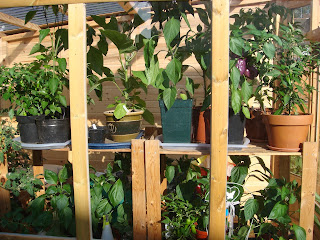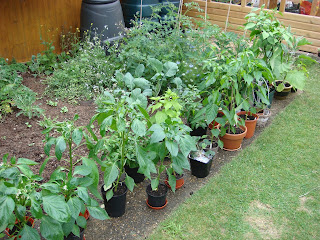1. Buy a half barrel that is water tight. We bought a red wine half barrel with a diameter of 73 cm for £54.99 from eBay/Celtic Timber. You need to make sure it's watertight before you buy it. Some are sold as planters with holes already drilled in the bottom and some may not be waterproof for other reasons.
2. Work out where you want to put it. You don't need to sink it into the ground, although it may not be as useful for wildlife if you don't. Nick Bailey recommended putting the pond in partial shade and near a route through between your garden and neighbouring wilder areas that wasn't blocked by a solid fence. I live in a suburban area and my garden is entirely surrounded by solid fence, so I made a choice based on aesthetics and where we had partial shade (=3-6 hours of sun a day). If you have a couple of options, it can help to physically move the barrel there and see how it looks.
3. Once, you've worked out where you're going to put it, if you've decided to sink it in the ground, dig a hole slightly bigger than the barrel.
4. Put the barrel in the hole to make sure the hole is the right size. The barrel rim should be a couple of centimetres higher than the surrounding earth to stop lots of earth falling into the pond. Once we had dug the correct size, we then took the barrel out again and stamped the earth down to try and make it more level. We then put some gravel in the hole to help with levelling (and to get rid of some spare gravel we had left over from another project). This is optional.
5. Use a spirit level to check if the barrel is completely level. If it isn't, keep working on it until you have it level.
6. Buy or find some bricks. Ones with holes in them are good. We used 10 and ours cost 74 p each from B&Q, but around half of them were already lying around the garden. We gave them a good rinse before we put them in the pond, as we didn't want to add unnecessary soil or brick dust.7. Place the bricks round the edges of the pond to create shelves of different heights to put your pond plants on. Our shelves are a mixture of two and three bricks deep. This is a good time to experiment with where the bricks go, as they will dictate where your plants go.
8. Make sure you have water available to go in your pond. Ideally this should be rainwater from a water butt. According to Nick Bailey, if you have to use tap water, allow it to stand for a few days first to allow it to neutralise. He didn't say, but I'm guessing you can leave it to stand in the barrel and just put your plants in after a few days. Don't use water from other ponds, as this could transfer disease to your pond.
8. Buy pond plants (aquatic plants) for the pond and place on the bricks. Make sure that the plants suit your pond conditions. I made sure all my plants were able to tolerate partial shade (they really need to be able to, that pond gets a maximum of 3 hours of sun a day). I also made sure they were suitable for small or medium ponds. I'm possibly pushing my luck a bit with plants suitable for medium ponds. Time will tell. Finally, I also made sure they were all suitable for planting depth zone 2 or 3. Based on the labels, planting depth zone 2 means the higher level of bricks in my pond and zone 3 means my lower level of bricks.
If you buy the plants already potted up in aquatic baskets (plastic plant pot-style baskets with holes in the sides), then you can just put the plants straight in the pond. If you buy them without the aquatic baskets, then you will need to pot them up yourself. Here's some information about that.
I picked a range of plants based partly on the ones Nick Bailey chose, partly on the fact that I wanted them all to have white flowers (I didn't quite succeed) and partly on the fact that another website recommended that I should include an oxgenator and partly based on what was available at my local garden centre. The plants were 3 for £12 or £5 each, so I spent £24.
My plants were:
- Slender club rush 'Scirpus cernuus' - my oxygenator
- Water plantain 'Alisma plantago' - the one I noticed too late wasn't quite white
- White water spearmint 'Preslia cervina alba'
- Iris (snow queen) - probably. It was a label stuck over the original label. When it grows it may turn out to be the blue bog iris, iris sibirica.
- Barred horsetail 'Equisetum Japonicum' x 2
The plants Nick Bailey mentioned in the show for in the pond were:
- Iris versicolour 'Blue flag'
- Rough horsetail - Equisetum hyemale'
- Pendulous sage - Carex pendula (this is a transitional plant that you can plant either inside or outside the pond)
- Water spearmint - Mentha cervina
- Nymphaea 'Solifatare' (minature waterlily)
- Ligularia dentata 'Dark beauty' (leopard plant)
- Dryopteris filix-mas (male fern)
Here's a link to another website which suggests further alternatives to Nick Bailey's choices and also names some of the plants he planted, but didn't name on camera.
I really want a miniature waterlily for my pond, but all of them say they need full sun, including the one Nick Bailey used. What's probably going to happen is that I'll see how the other plants get on and leave the decision till next year. Anyhow, on with the instructions.
9. Pour in the water. Mine took around 15 7-litre watering cans full, i.e. around 105 litres less splashes etc.
10. Add some pond dye in order to prevent algae from growing and taking over your pond. Stir. We chose black because it mainly just makes it look like our pond is just much deeper than it is. Nick Bailey said you hardly need to use any of it. The show showed him adding about 1/6 of a teaspoon. The dye I bought from Amazon (£14.95) said I should use a 5 ml scoop per 40 litres. Torn between what it said to do on the pack (2.5 scoops for 100 litres) and Nick Bailey's suggestion that you hardly need any, I put 2 scoops in. In retrospect, I think that was too much and the pond is darker than necessary. Next time (in about 3 months according to the pack), I'll try using much less. The pack I bought came with gloves (to stop it staining your hands, it's non-toxic) and a 5 ml scoop.
11. Fill in the soil around the pond. Nick Bailey said to soak the barrel to expand it and make it waterproof before using it. We figured that soaking it was very similar to filling it, so we decided to simply keep an eye on it for whether we needed to top it up and leave it a week before filling the soil in, in case it makes a difference. We're not sure how much difference it made. It stopped noticeably seeping water from the sides during that time, but after I added the dye, this seeped into the barrel too and the staining pattern changed every time it rained. Also, it barely lost any water even when you could see small amounts seeping out the side.11. Add some plants around the pond.
12. If your pond is a bit higher out of the ground than mine, add some stones by the rim to act as a bridge for wildlife getting into the pond.
My original plan was to plant the surrounding area up with carex pendula and ferns and other similar plants like Nick Bailey did. However, at this point I realised a) that I'd already spent nearly £100 on the pond (which made me feel a bit guilty) and b) that ferns and similar plants were not cheap (and I had no guarantee that they weren't going to prove unsuitable for the area and die).
Obviously, in an area that only gets 3 hours of sun a day (between about 8.45 and 11.45 a.m.), I need plants that tolerate shade well. Even though it's been raining a lot recently and the pond is completely full and has almost certainly overflowed, it doesn't seem to get wet to the point of marshiness there. So what I decided to do was to transplant some shade-loving British native plants there that I was already growing seedlings of. It now has a mixture of foxgloves and honesty seedlings growing round the edge. Both are partial-shade-tolerant biennials and should flower next year, if they survive transplantation. I'm certain the honesty will survive, I've transplanted that before. It's a matter of wait and see with the foxgloves. I will also be open to letting anything attractive that seeds itself there stay there.
Currently, I'd still like to add some ferns, but I'm also open to seeing what develops.
Here's a view of the garden from above so you can see how the pond fits into it. Clue: It's on the far right more or less opposite the greenhouse door, just in front of the apple tree, behind a pile of earth that I will be gradually spreading over the rest of the garden or otherwise removing.
Edited: You also need to add a way for wildlife to get into and out of the pond, for instance a plank of wood in the pond that provides a gentle slope for any creatures to crawl out of. Also, it's well worth checking which ponds plants can withstand frost and what you need to do over winter with any that can't. Most of my pond plants died in the first winter.
















































